PEV205 Corporate Hospitality: Group Collaboration Report - GSM 2017
VerifiedAdded on 2023/06/15
|10
|2133
|370
Report
AI Summary
This reflective report discusses a collaborative task performed at GSM, focusing on a group presentation. It highlights the development of personal traits, individual roles, and group interactions. The report analyzes communication skills, group formation, and problem-solving strategies employed during the assignment. It also addresses challenges faced due to diverse backgrounds and dominant personalities within the group, along with recommendations for improvement, including structured frameworks and inclusive communication practices. The report concludes by reflecting on how corporate events enhance business profiles, emphasizing the lessons learned in teamwork, decision-making, and handling pressure, with Desklib offering access to similar solved assignments and study resources.
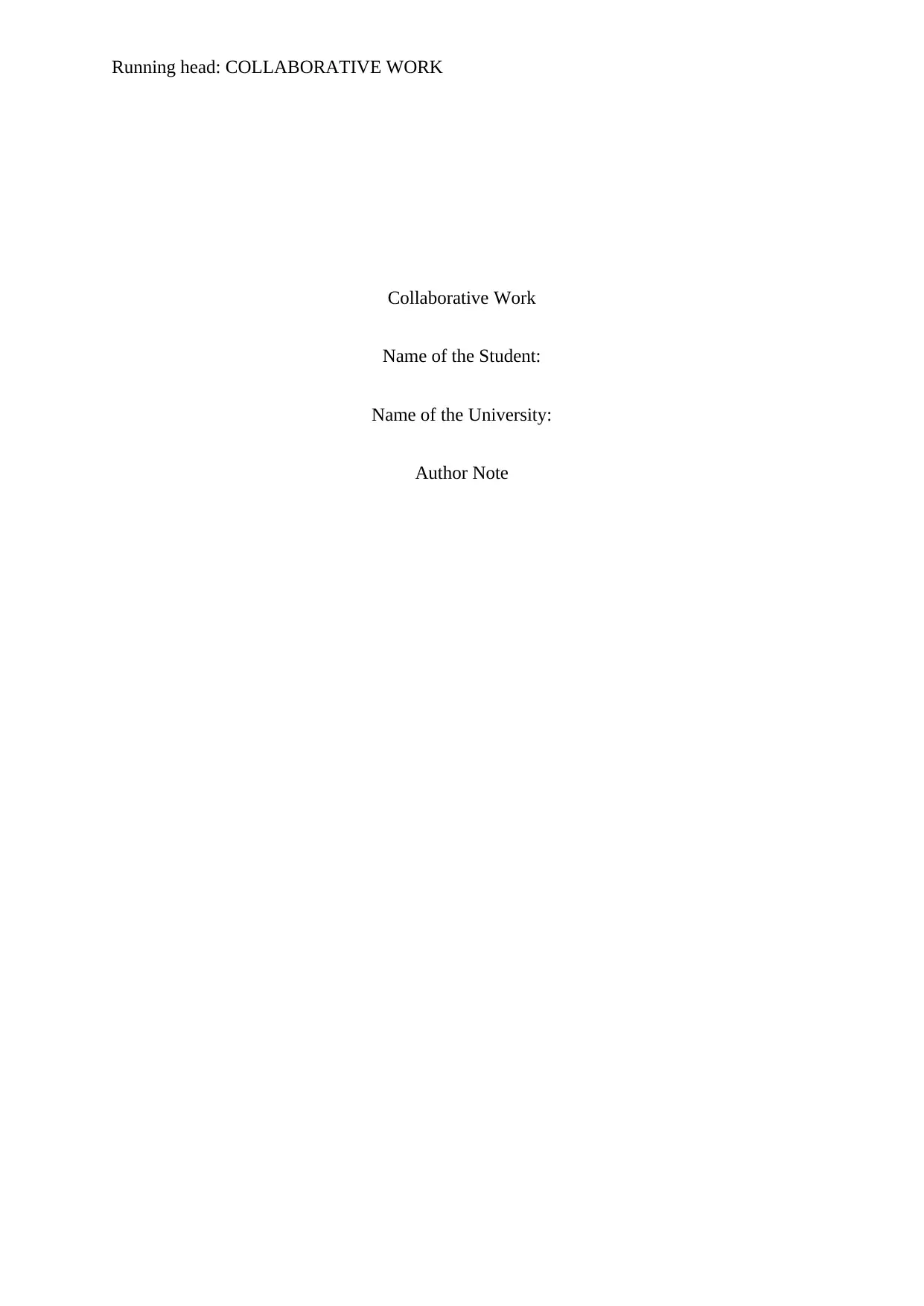
Running head: COLLABORATIVE WORK
Collaborative Work
Name of the Student:
Name of the University:
Author Note
Collaborative Work
Name of the Student:
Name of the University:
Author Note
Paraphrase This Document
Need a fresh take? Get an instant paraphrase of this document with our AI Paraphraser
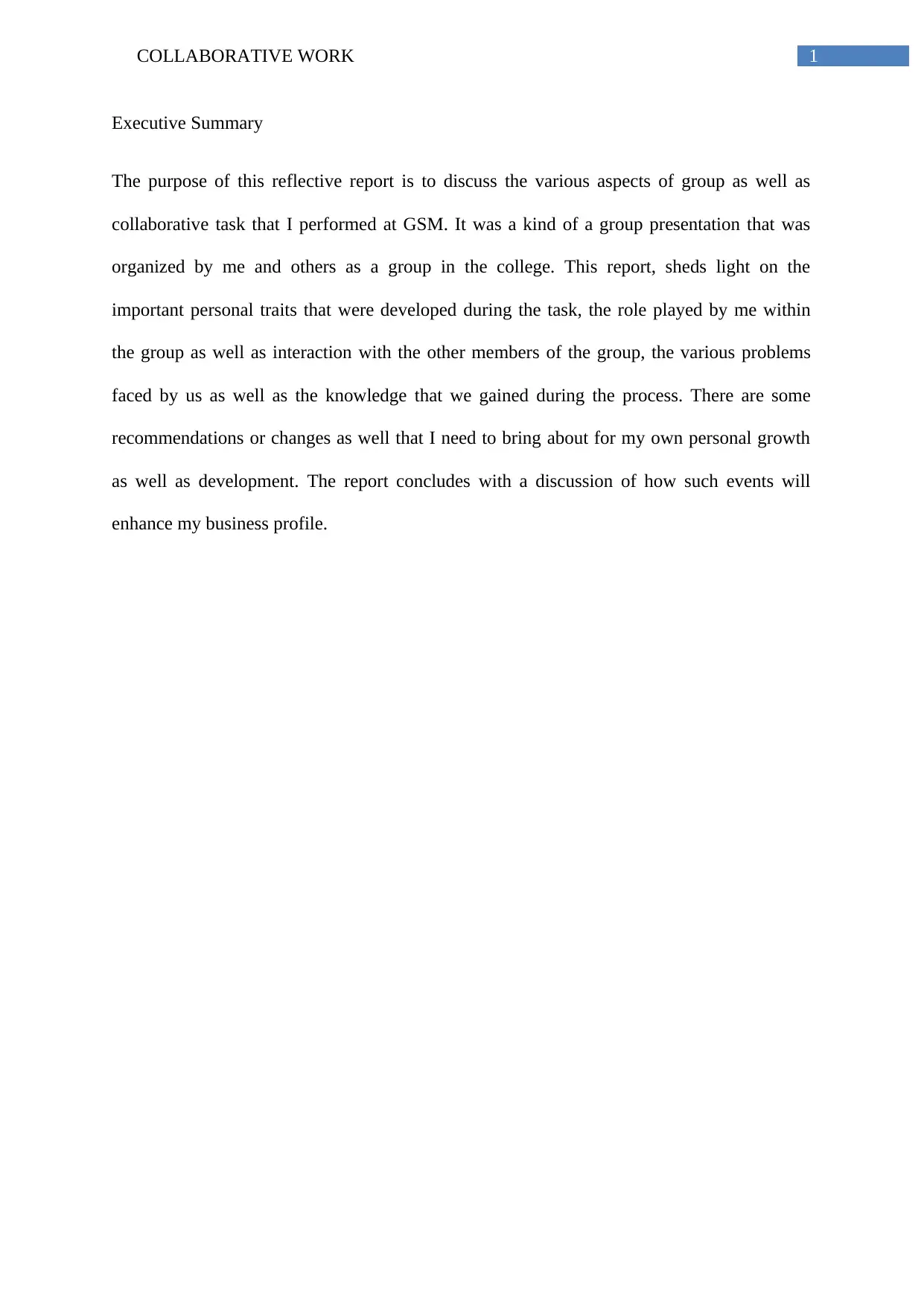
1COLLABORATIVE WORK
Executive Summary
The purpose of this reflective report is to discuss the various aspects of group as well as
collaborative task that I performed at GSM. It was a kind of a group presentation that was
organized by me and others as a group in the college. This report, sheds light on the
important personal traits that were developed during the task, the role played by me within
the group as well as interaction with the other members of the group, the various problems
faced by us as well as the knowledge that we gained during the process. There are some
recommendations or changes as well that I need to bring about for my own personal growth
as well as development. The report concludes with a discussion of how such events will
enhance my business profile.
Executive Summary
The purpose of this reflective report is to discuss the various aspects of group as well as
collaborative task that I performed at GSM. It was a kind of a group presentation that was
organized by me and others as a group in the college. This report, sheds light on the
important personal traits that were developed during the task, the role played by me within
the group as well as interaction with the other members of the group, the various problems
faced by us as well as the knowledge that we gained during the process. There are some
recommendations or changes as well that I need to bring about for my own personal growth
as well as development. The report concludes with a discussion of how such events will
enhance my business profile.
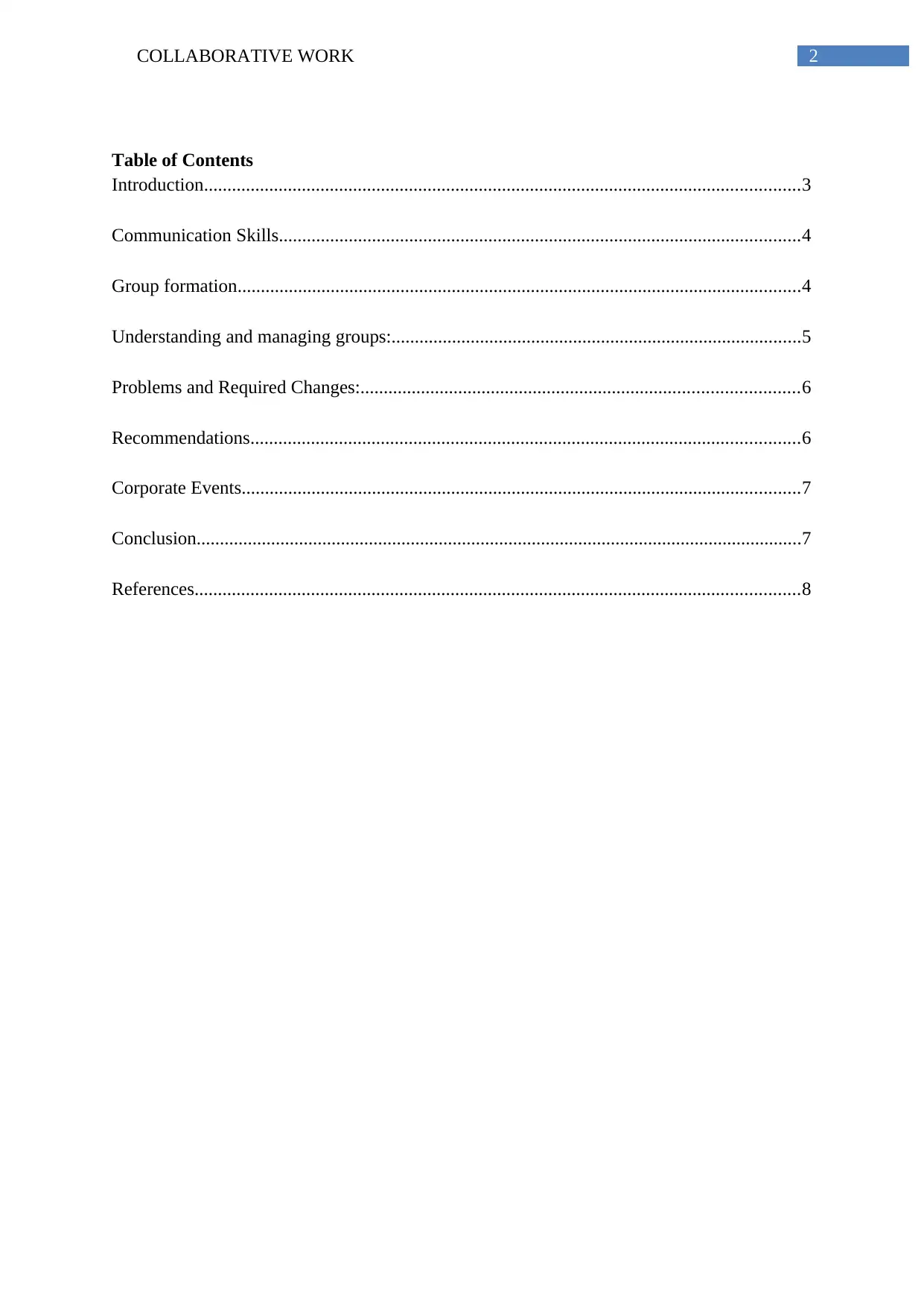
2COLLABORATIVE WORK
Table of Contents
Introduction................................................................................................................................3
Communication Skills................................................................................................................4
Group formation.........................................................................................................................4
Understanding and managing groups:........................................................................................5
Problems and Required Changes:..............................................................................................6
Recommendations......................................................................................................................6
Corporate Events........................................................................................................................7
Conclusion..................................................................................................................................7
References..................................................................................................................................8
Table of Contents
Introduction................................................................................................................................3
Communication Skills................................................................................................................4
Group formation.........................................................................................................................4
Understanding and managing groups:........................................................................................5
Problems and Required Changes:..............................................................................................6
Recommendations......................................................................................................................6
Corporate Events........................................................................................................................7
Conclusion..................................................................................................................................7
References..................................................................................................................................8
⊘ This is a preview!⊘
Do you want full access?
Subscribe today to unlock all pages.

Trusted by 1+ million students worldwide
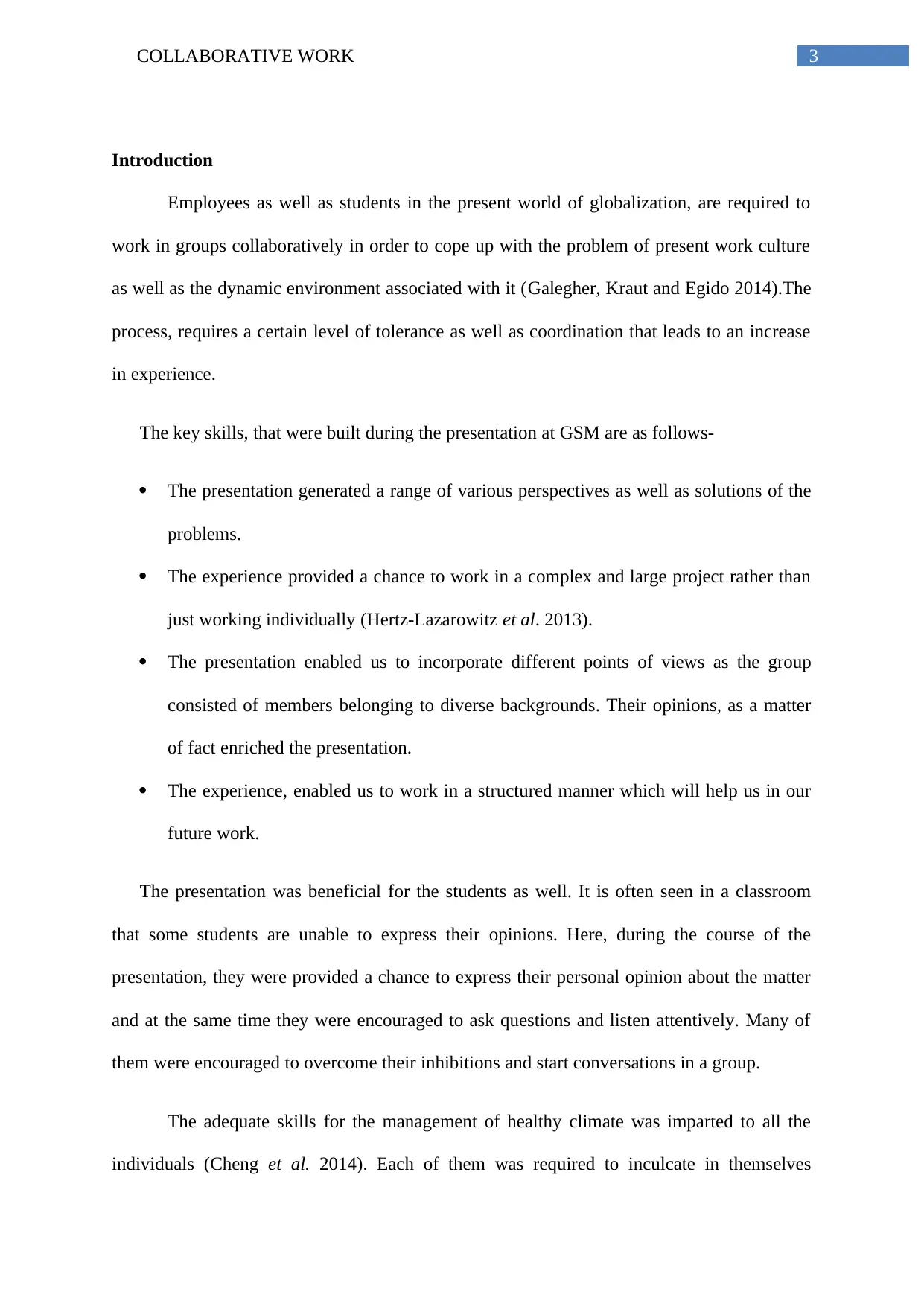
3COLLABORATIVE WORK
Introduction
Employees as well as students in the present world of globalization, are required to
work in groups collaboratively in order to cope up with the problem of present work culture
as well as the dynamic environment associated with it (Galegher, Kraut and Egido 2014).The
process, requires a certain level of tolerance as well as coordination that leads to an increase
in experience.
The key skills, that were built during the presentation at GSM are as follows-
The presentation generated a range of various perspectives as well as solutions of the
problems.
The experience provided a chance to work in a complex and large project rather than
just working individually (Hertz-Lazarowitz et al. 2013).
The presentation enabled us to incorporate different points of views as the group
consisted of members belonging to diverse backgrounds. Their opinions, as a matter
of fact enriched the presentation.
The experience, enabled us to work in a structured manner which will help us in our
future work.
The presentation was beneficial for the students as well. It is often seen in a classroom
that some students are unable to express their opinions. Here, during the course of the
presentation, they were provided a chance to express their personal opinion about the matter
and at the same time they were encouraged to ask questions and listen attentively. Many of
them were encouraged to overcome their inhibitions and start conversations in a group.
The adequate skills for the management of healthy climate was imparted to all the
individuals (Cheng et al. 2014). Each of them was required to inculcate in themselves
Introduction
Employees as well as students in the present world of globalization, are required to
work in groups collaboratively in order to cope up with the problem of present work culture
as well as the dynamic environment associated with it (Galegher, Kraut and Egido 2014).The
process, requires a certain level of tolerance as well as coordination that leads to an increase
in experience.
The key skills, that were built during the presentation at GSM are as follows-
The presentation generated a range of various perspectives as well as solutions of the
problems.
The experience provided a chance to work in a complex and large project rather than
just working individually (Hertz-Lazarowitz et al. 2013).
The presentation enabled us to incorporate different points of views as the group
consisted of members belonging to diverse backgrounds. Their opinions, as a matter
of fact enriched the presentation.
The experience, enabled us to work in a structured manner which will help us in our
future work.
The presentation was beneficial for the students as well. It is often seen in a classroom
that some students are unable to express their opinions. Here, during the course of the
presentation, they were provided a chance to express their personal opinion about the matter
and at the same time they were encouraged to ask questions and listen attentively. Many of
them were encouraged to overcome their inhibitions and start conversations in a group.
The adequate skills for the management of healthy climate was imparted to all the
individuals (Cheng et al. 2014). Each of them was required to inculcate in themselves
Paraphrase This Document
Need a fresh take? Get an instant paraphrase of this document with our AI Paraphraser
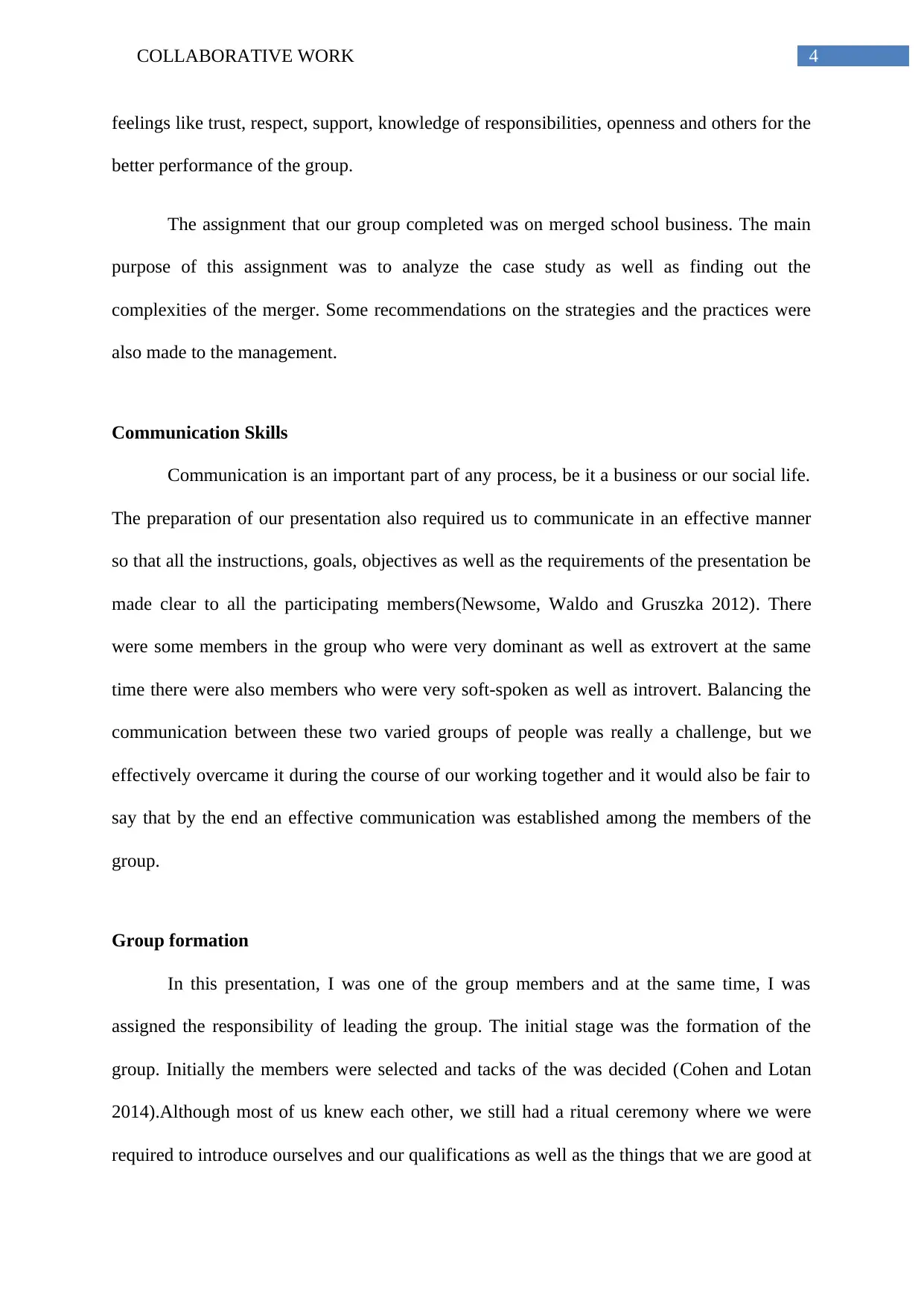
4COLLABORATIVE WORK
feelings like trust, respect, support, knowledge of responsibilities, openness and others for the
better performance of the group.
The assignment that our group completed was on merged school business. The main
purpose of this assignment was to analyze the case study as well as finding out the
complexities of the merger. Some recommendations on the strategies and the practices were
also made to the management.
Communication Skills
Communication is an important part of any process, be it a business or our social life.
The preparation of our presentation also required us to communicate in an effective manner
so that all the instructions, goals, objectives as well as the requirements of the presentation be
made clear to all the participating members(Newsome, Waldo and Gruszka 2012). There
were some members in the group who were very dominant as well as extrovert at the same
time there were also members who were very soft-spoken as well as introvert. Balancing the
communication between these two varied groups of people was really a challenge, but we
effectively overcame it during the course of our working together and it would also be fair to
say that by the end an effective communication was established among the members of the
group.
Group formation
In this presentation, I was one of the group members and at the same time, I was
assigned the responsibility of leading the group. The initial stage was the formation of the
group. Initially the members were selected and tacks of the was decided (Cohen and Lotan
2014).Although most of us knew each other, we still had a ritual ceremony where we were
required to introduce ourselves and our qualifications as well as the things that we are good at
feelings like trust, respect, support, knowledge of responsibilities, openness and others for the
better performance of the group.
The assignment that our group completed was on merged school business. The main
purpose of this assignment was to analyze the case study as well as finding out the
complexities of the merger. Some recommendations on the strategies and the practices were
also made to the management.
Communication Skills
Communication is an important part of any process, be it a business or our social life.
The preparation of our presentation also required us to communicate in an effective manner
so that all the instructions, goals, objectives as well as the requirements of the presentation be
made clear to all the participating members(Newsome, Waldo and Gruszka 2012). There
were some members in the group who were very dominant as well as extrovert at the same
time there were also members who were very soft-spoken as well as introvert. Balancing the
communication between these two varied groups of people was really a challenge, but we
effectively overcame it during the course of our working together and it would also be fair to
say that by the end an effective communication was established among the members of the
group.
Group formation
In this presentation, I was one of the group members and at the same time, I was
assigned the responsibility of leading the group. The initial stage was the formation of the
group. Initially the members were selected and tacks of the was decided (Cohen and Lotan
2014).Although most of us knew each other, we still had a ritual ceremony where we were
required to introduce ourselves and our qualifications as well as the things that we are good at
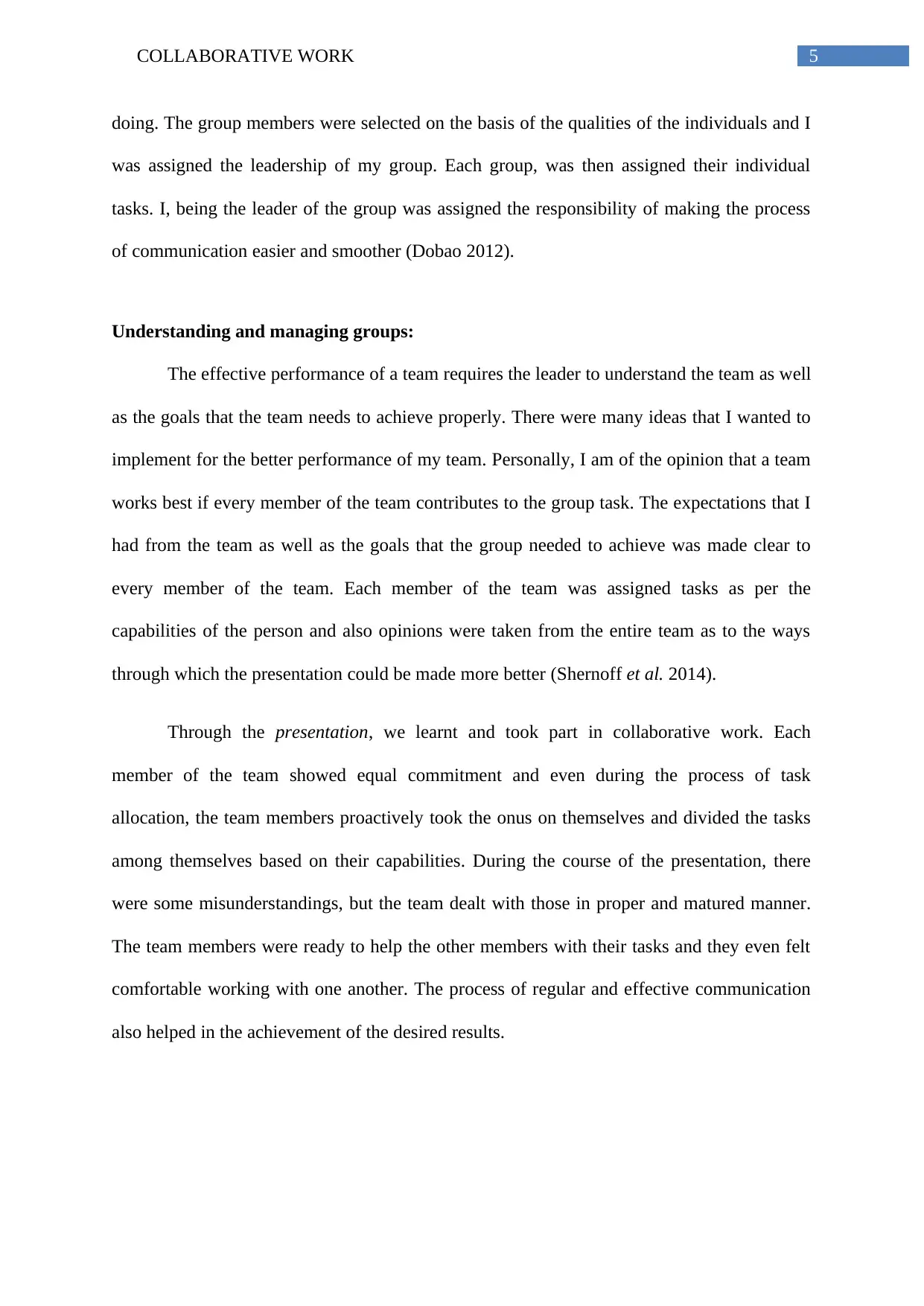
5COLLABORATIVE WORK
doing. The group members were selected on the basis of the qualities of the individuals and I
was assigned the leadership of my group. Each group, was then assigned their individual
tasks. I, being the leader of the group was assigned the responsibility of making the process
of communication easier and smoother (Dobao 2012).
Understanding and managing groups:
The effective performance of a team requires the leader to understand the team as well
as the goals that the team needs to achieve properly. There were many ideas that I wanted to
implement for the better performance of my team. Personally, I am of the opinion that a team
works best if every member of the team contributes to the group task. The expectations that I
had from the team as well as the goals that the group needed to achieve was made clear to
every member of the team. Each member of the team was assigned tasks as per the
capabilities of the person and also opinions were taken from the entire team as to the ways
through which the presentation could be made more better (Shernoff et al. 2014).
Through the presentation, we learnt and took part in collaborative work. Each
member of the team showed equal commitment and even during the process of task
allocation, the team members proactively took the onus on themselves and divided the tasks
among themselves based on their capabilities. During the course of the presentation, there
were some misunderstandings, but the team dealt with those in proper and matured manner.
The team members were ready to help the other members with their tasks and they even felt
comfortable working with one another. The process of regular and effective communication
also helped in the achievement of the desired results.
doing. The group members were selected on the basis of the qualities of the individuals and I
was assigned the leadership of my group. Each group, was then assigned their individual
tasks. I, being the leader of the group was assigned the responsibility of making the process
of communication easier and smoother (Dobao 2012).
Understanding and managing groups:
The effective performance of a team requires the leader to understand the team as well
as the goals that the team needs to achieve properly. There were many ideas that I wanted to
implement for the better performance of my team. Personally, I am of the opinion that a team
works best if every member of the team contributes to the group task. The expectations that I
had from the team as well as the goals that the group needed to achieve was made clear to
every member of the team. Each member of the team was assigned tasks as per the
capabilities of the person and also opinions were taken from the entire team as to the ways
through which the presentation could be made more better (Shernoff et al. 2014).
Through the presentation, we learnt and took part in collaborative work. Each
member of the team showed equal commitment and even during the process of task
allocation, the team members proactively took the onus on themselves and divided the tasks
among themselves based on their capabilities. During the course of the presentation, there
were some misunderstandings, but the team dealt with those in proper and matured manner.
The team members were ready to help the other members with their tasks and they even felt
comfortable working with one another. The process of regular and effective communication
also helped in the achievement of the desired results.
⊘ This is a preview!⊘
Do you want full access?
Subscribe today to unlock all pages.

Trusted by 1+ million students worldwide
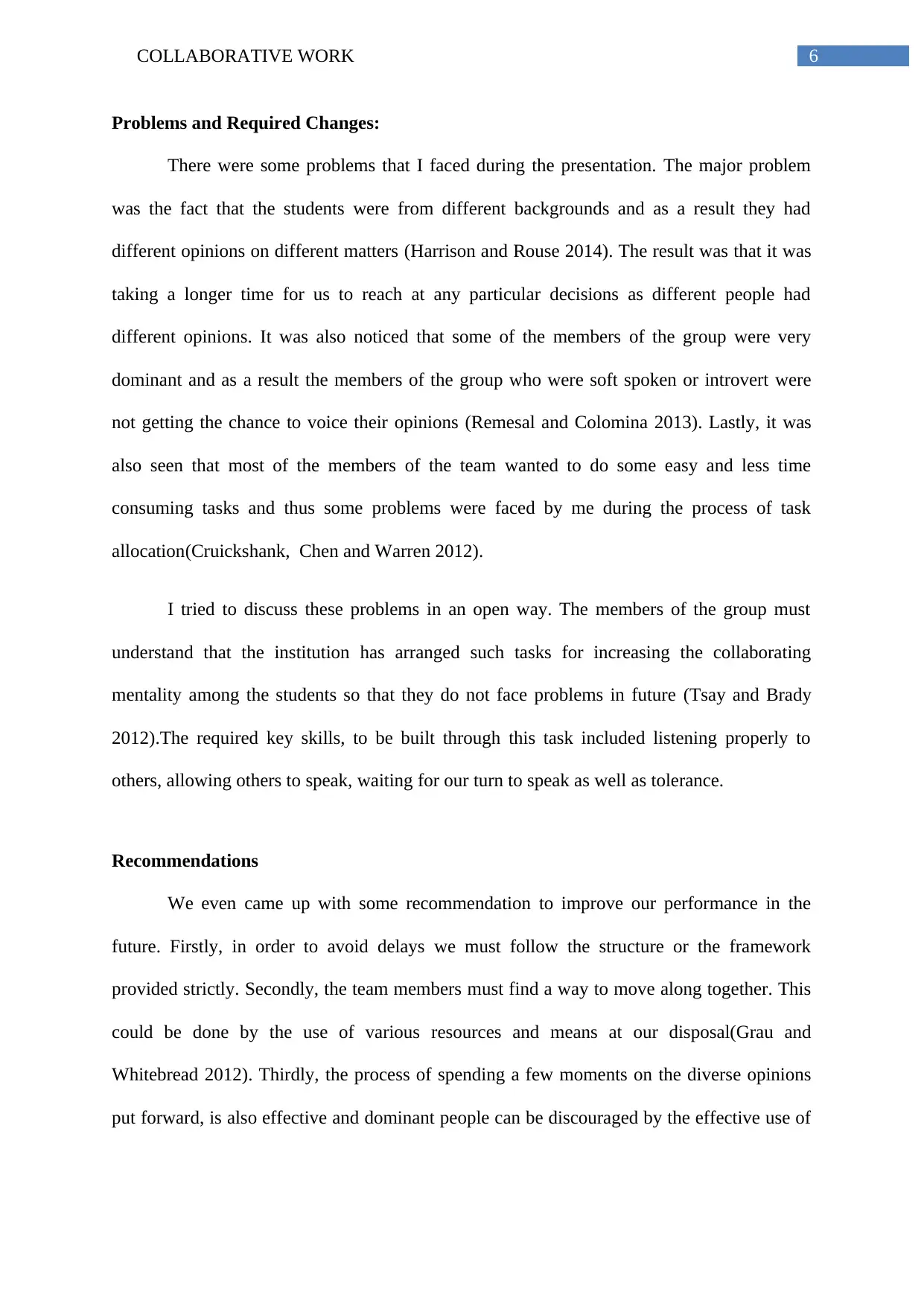
6COLLABORATIVE WORK
Problems and Required Changes:
There were some problems that I faced during the presentation. The major problem
was the fact that the students were from different backgrounds and as a result they had
different opinions on different matters (Harrison and Rouse 2014). The result was that it was
taking a longer time for us to reach at any particular decisions as different people had
different opinions. It was also noticed that some of the members of the group were very
dominant and as a result the members of the group who were soft spoken or introvert were
not getting the chance to voice their opinions (Remesal and Colomina 2013). Lastly, it was
also seen that most of the members of the team wanted to do some easy and less time
consuming tasks and thus some problems were faced by me during the process of task
allocation(Cruickshank, Chen and Warren 2012).
I tried to discuss these problems in an open way. The members of the group must
understand that the institution has arranged such tasks for increasing the collaborating
mentality among the students so that they do not face problems in future (Tsay and Brady
2012).The required key skills, to be built through this task included listening properly to
others, allowing others to speak, waiting for our turn to speak as well as tolerance.
Recommendations
We even came up with some recommendation to improve our performance in the
future. Firstly, in order to avoid delays we must follow the structure or the framework
provided strictly. Secondly, the team members must find a way to move along together. This
could be done by the use of various resources and means at our disposal(Grau and
Whitebread 2012). Thirdly, the process of spending a few moments on the diverse opinions
put forward, is also effective and dominant people can be discouraged by the effective use of
Problems and Required Changes:
There were some problems that I faced during the presentation. The major problem
was the fact that the students were from different backgrounds and as a result they had
different opinions on different matters (Harrison and Rouse 2014). The result was that it was
taking a longer time for us to reach at any particular decisions as different people had
different opinions. It was also noticed that some of the members of the group were very
dominant and as a result the members of the group who were soft spoken or introvert were
not getting the chance to voice their opinions (Remesal and Colomina 2013). Lastly, it was
also seen that most of the members of the team wanted to do some easy and less time
consuming tasks and thus some problems were faced by me during the process of task
allocation(Cruickshank, Chen and Warren 2012).
I tried to discuss these problems in an open way. The members of the group must
understand that the institution has arranged such tasks for increasing the collaborating
mentality among the students so that they do not face problems in future (Tsay and Brady
2012).The required key skills, to be built through this task included listening properly to
others, allowing others to speak, waiting for our turn to speak as well as tolerance.
Recommendations
We even came up with some recommendation to improve our performance in the
future. Firstly, in order to avoid delays we must follow the structure or the framework
provided strictly. Secondly, the team members must find a way to move along together. This
could be done by the use of various resources and means at our disposal(Grau and
Whitebread 2012). Thirdly, the process of spending a few moments on the diverse opinions
put forward, is also effective and dominant people can be discouraged by the effective use of
Paraphrase This Document
Need a fresh take? Get an instant paraphrase of this document with our AI Paraphraser
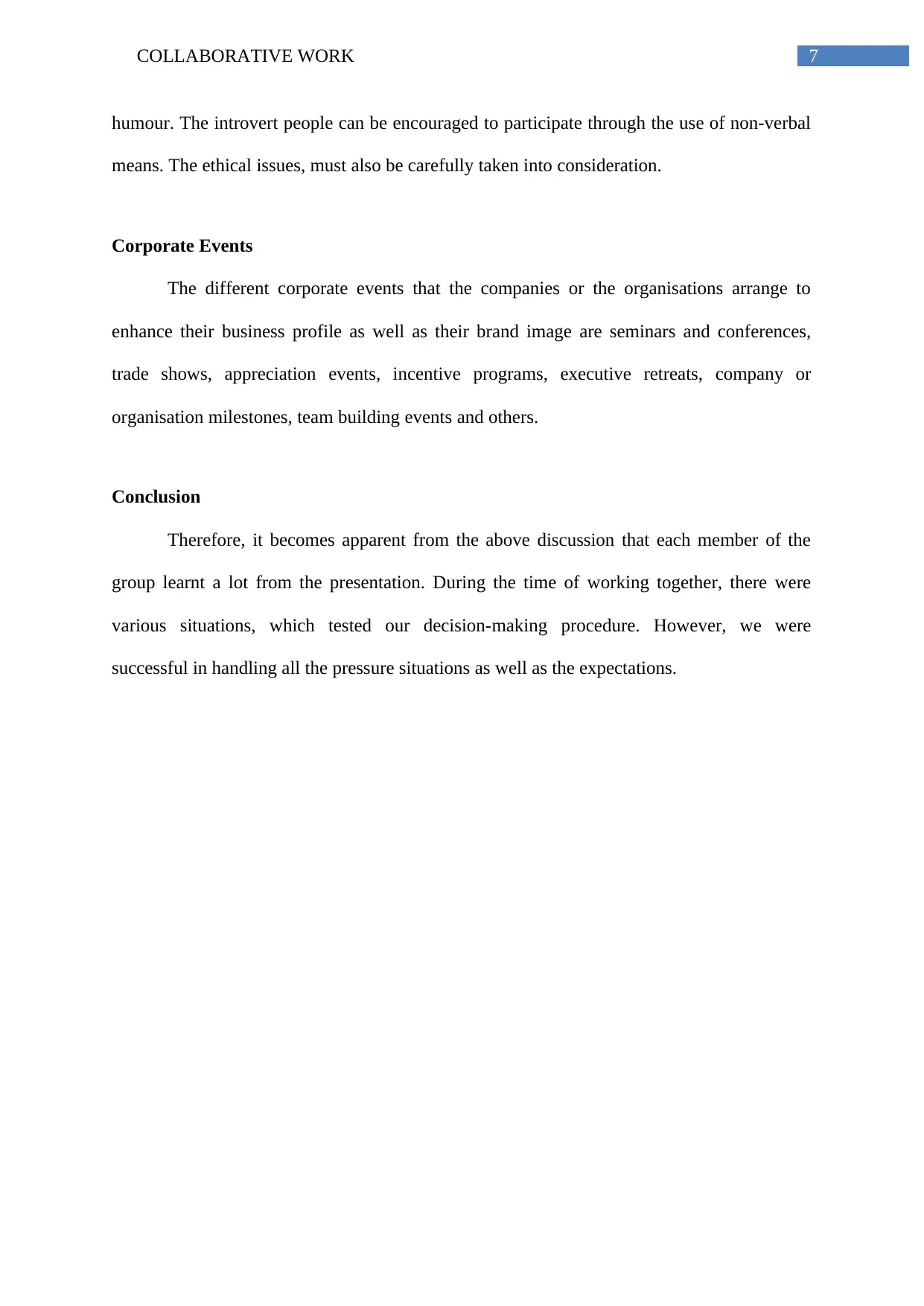
7COLLABORATIVE WORK
humour. The introvert people can be encouraged to participate through the use of non-verbal
means. The ethical issues, must also be carefully taken into consideration.
Corporate Events
The different corporate events that the companies or the organisations arrange to
enhance their business profile as well as their brand image are seminars and conferences,
trade shows, appreciation events, incentive programs, executive retreats, company or
organisation milestones, team building events and others.
Conclusion
Therefore, it becomes apparent from the above discussion that each member of the
group learnt a lot from the presentation. During the time of working together, there were
various situations, which tested our decision-making procedure. However, we were
successful in handling all the pressure situations as well as the expectations.
humour. The introvert people can be encouraged to participate through the use of non-verbal
means. The ethical issues, must also be carefully taken into consideration.
Corporate Events
The different corporate events that the companies or the organisations arrange to
enhance their business profile as well as their brand image are seminars and conferences,
trade shows, appreciation events, incentive programs, executive retreats, company or
organisation milestones, team building events and others.
Conclusion
Therefore, it becomes apparent from the above discussion that each member of the
group learnt a lot from the presentation. During the time of working together, there were
various situations, which tested our decision-making procedure. However, we were
successful in handling all the pressure situations as well as the expectations.
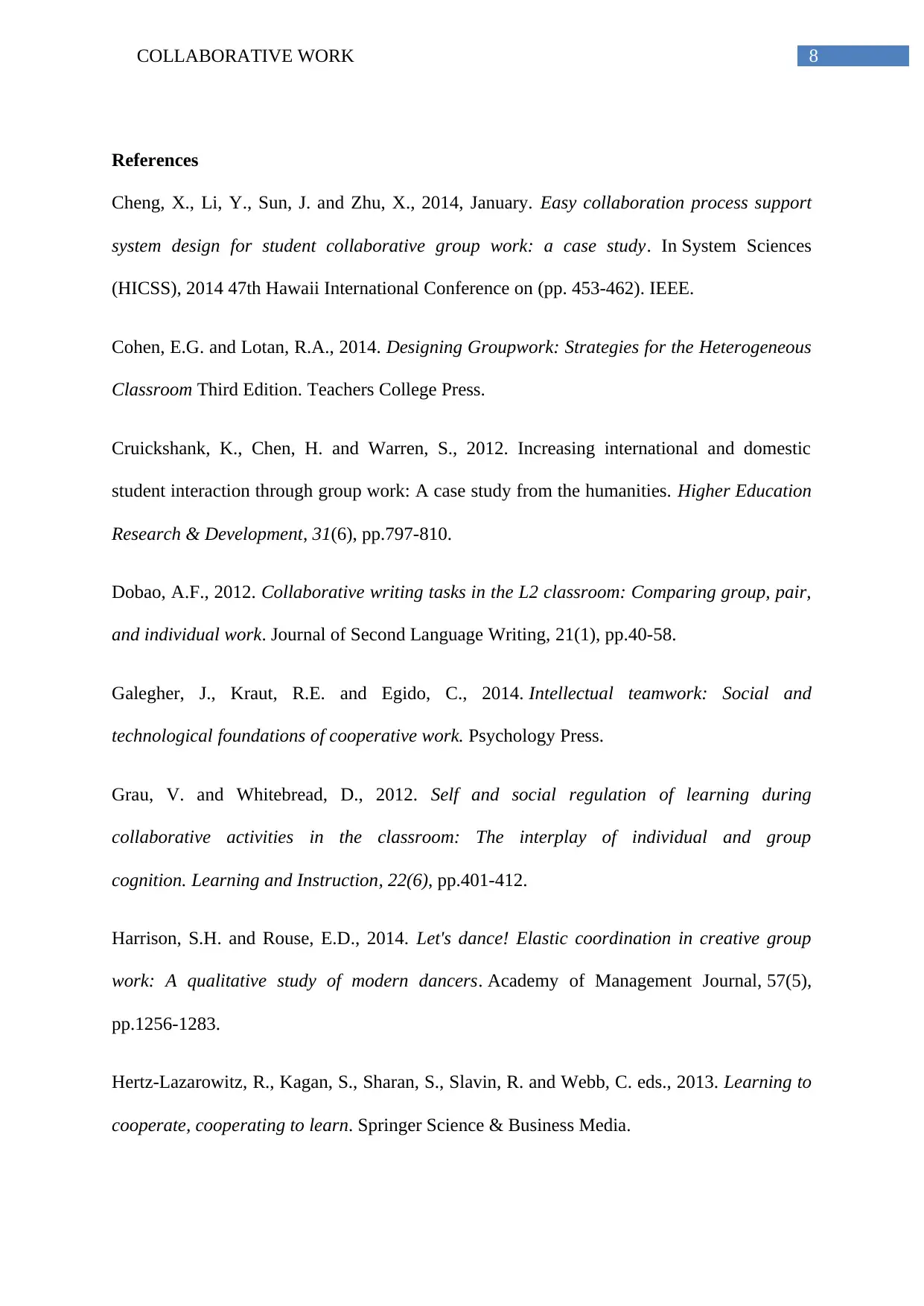
8COLLABORATIVE WORK
References
Cheng, X., Li, Y., Sun, J. and Zhu, X., 2014, January. Easy collaboration process support
system design for student collaborative group work: a case study. In System Sciences
(HICSS), 2014 47th Hawaii International Conference on (pp. 453-462). IEEE.
Cohen, E.G. and Lotan, R.A., 2014. Designing Groupwork: Strategies for the Heterogeneous
Classroom Third Edition. Teachers College Press.
Cruickshank, K., Chen, H. and Warren, S., 2012. Increasing international and domestic
student interaction through group work: A case study from the humanities. Higher Education
Research & Development, 31(6), pp.797-810.
Dobao, A.F., 2012. Collaborative writing tasks in the L2 classroom: Comparing group, pair,
and individual work. Journal of Second Language Writing, 21(1), pp.40-58.
Galegher, J., Kraut, R.E. and Egido, C., 2014. Intellectual teamwork: Social and
technological foundations of cooperative work. Psychology Press.
Grau, V. and Whitebread, D., 2012. Self and social regulation of learning during
collaborative activities in the classroom: The interplay of individual and group
cognition. Learning and Instruction, 22(6), pp.401-412.
Harrison, S.H. and Rouse, E.D., 2014. Let's dance! Elastic coordination in creative group
work: A qualitative study of modern dancers. Academy of Management Journal, 57(5),
pp.1256-1283.
Hertz-Lazarowitz, R., Kagan, S., Sharan, S., Slavin, R. and Webb, C. eds., 2013. Learning to
cooperate, cooperating to learn. Springer Science & Business Media.
References
Cheng, X., Li, Y., Sun, J. and Zhu, X., 2014, January. Easy collaboration process support
system design for student collaborative group work: a case study. In System Sciences
(HICSS), 2014 47th Hawaii International Conference on (pp. 453-462). IEEE.
Cohen, E.G. and Lotan, R.A., 2014. Designing Groupwork: Strategies for the Heterogeneous
Classroom Third Edition. Teachers College Press.
Cruickshank, K., Chen, H. and Warren, S., 2012. Increasing international and domestic
student interaction through group work: A case study from the humanities. Higher Education
Research & Development, 31(6), pp.797-810.
Dobao, A.F., 2012. Collaborative writing tasks in the L2 classroom: Comparing group, pair,
and individual work. Journal of Second Language Writing, 21(1), pp.40-58.
Galegher, J., Kraut, R.E. and Egido, C., 2014. Intellectual teamwork: Social and
technological foundations of cooperative work. Psychology Press.
Grau, V. and Whitebread, D., 2012. Self and social regulation of learning during
collaborative activities in the classroom: The interplay of individual and group
cognition. Learning and Instruction, 22(6), pp.401-412.
Harrison, S.H. and Rouse, E.D., 2014. Let's dance! Elastic coordination in creative group
work: A qualitative study of modern dancers. Academy of Management Journal, 57(5),
pp.1256-1283.
Hertz-Lazarowitz, R., Kagan, S., Sharan, S., Slavin, R. and Webb, C. eds., 2013. Learning to
cooperate, cooperating to learn. Springer Science & Business Media.
⊘ This is a preview!⊘
Do you want full access?
Subscribe today to unlock all pages.

Trusted by 1+ million students worldwide
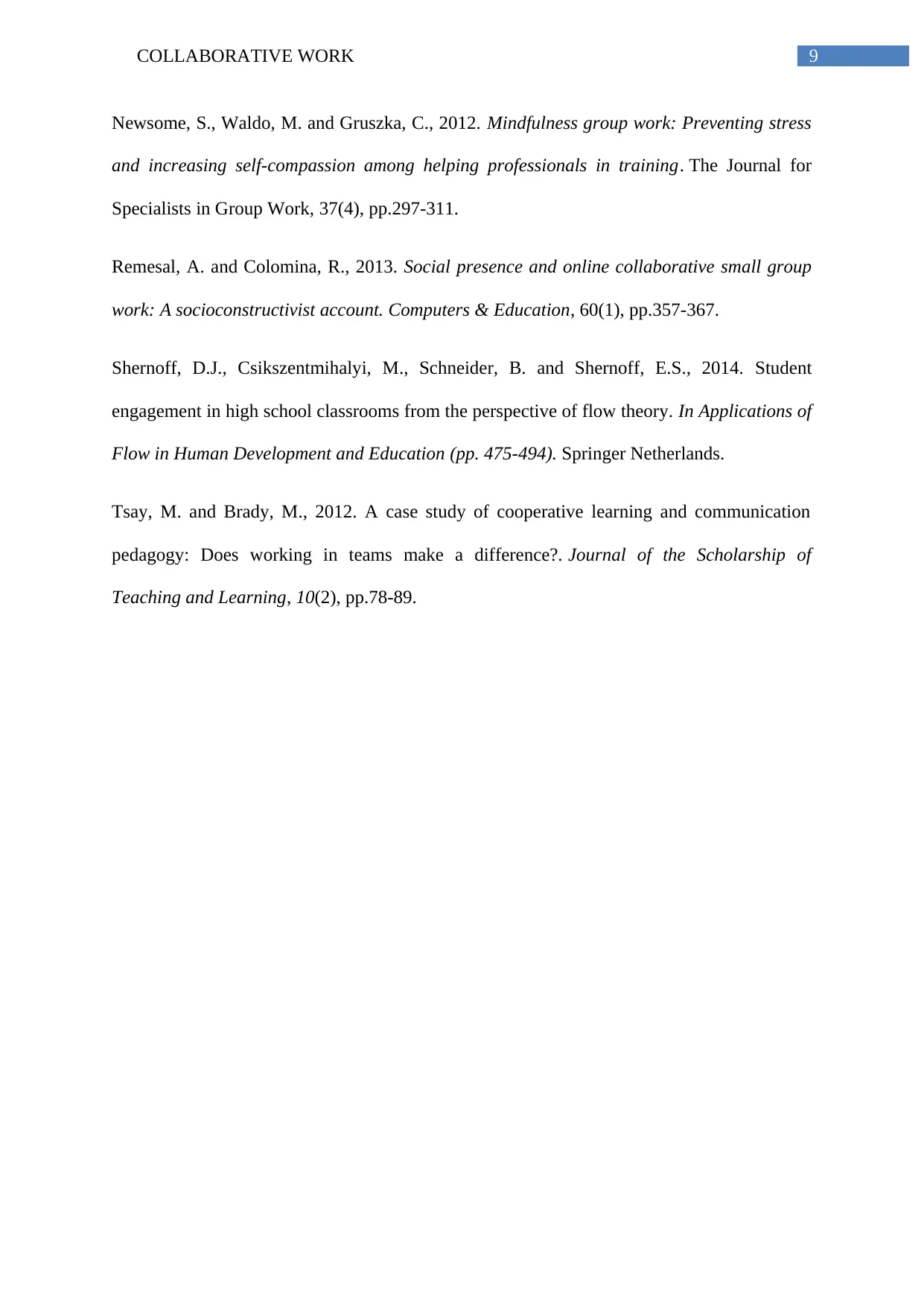
9COLLABORATIVE WORK
Newsome, S., Waldo, M. and Gruszka, C., 2012. Mindfulness group work: Preventing stress
and increasing self-compassion among helping professionals in training. The Journal for
Specialists in Group Work, 37(4), pp.297-311.
Remesal, A. and Colomina, R., 2013. Social presence and online collaborative small group
work: A socioconstructivist account. Computers & Education, 60(1), pp.357-367.
Shernoff, D.J., Csikszentmihalyi, M., Schneider, B. and Shernoff, E.S., 2014. Student
engagement in high school classrooms from the perspective of flow theory. In Applications of
Flow in Human Development and Education (pp. 475-494). Springer Netherlands.
Tsay, M. and Brady, M., 2012. A case study of cooperative learning and communication
pedagogy: Does working in teams make a difference?. Journal of the Scholarship of
Teaching and Learning, 10(2), pp.78-89.
Newsome, S., Waldo, M. and Gruszka, C., 2012. Mindfulness group work: Preventing stress
and increasing self-compassion among helping professionals in training. The Journal for
Specialists in Group Work, 37(4), pp.297-311.
Remesal, A. and Colomina, R., 2013. Social presence and online collaborative small group
work: A socioconstructivist account. Computers & Education, 60(1), pp.357-367.
Shernoff, D.J., Csikszentmihalyi, M., Schneider, B. and Shernoff, E.S., 2014. Student
engagement in high school classrooms from the perspective of flow theory. In Applications of
Flow in Human Development and Education (pp. 475-494). Springer Netherlands.
Tsay, M. and Brady, M., 2012. A case study of cooperative learning and communication
pedagogy: Does working in teams make a difference?. Journal of the Scholarship of
Teaching and Learning, 10(2), pp.78-89.
1 out of 10
Related Documents
Your All-in-One AI-Powered Toolkit for Academic Success.
+13062052269
info@desklib.com
Available 24*7 on WhatsApp / Email
![[object Object]](/_next/static/media/star-bottom.7253800d.svg)
Unlock your academic potential
Copyright © 2020–2025 A2Z Services. All Rights Reserved. Developed and managed by ZUCOL.





